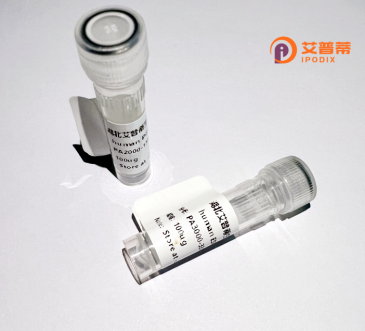
| 纯度 | >90%SDS-PAGE. |
| 种属 | Human |
| 靶点 | PIGV |
| Uniprot No | Q9NUD9 |
| 内毒素 | < 0.01EU/μg |
| 表达宿主 | E.coli |
| 表达区间 | 1-493 aa |
| 活性数据 | MWPQDPSRKEVLRFAVSCRILTLMLQALFNAIIPDHHAEAFSPPRLAPSGFVDQLVEGLLGGLSHWDAEHFLFIAEHGYLYEHNFAFFPGFPLALLVGTELLRPLRGLLSLRSCLLISVASLNFLFFMLAAVALHDLGCLVLHCPHQSFYAALLFCLSPANVFLAAGYSEALFALLTFSAMGQLERGRVWTSVLLFAFATGVRSNGLVSVGFLMHSQCQGFFSSLTMLNPLRQLFKLMASLFLSVFTLGLPFALFQYYAYTQFCLPGSARPIPEPLVQLAVDKGYRIAEGNEPPWCFWDVPLIYSYIQDVYWNVGFLKYYELKQVPNFLLAAPVAILVAWATWTYVTTHPWLCLTLGLQRSKNNKTLEKPDLGFLSPQVFVYVVHAAVLLLFGGLCMHVQVLTRFLGSSTPIMYWFPAHLLQDQEPLLRSLKTVPWKPLAEDSPPGQKVPRNPIMGLLYHWKTCSPVTRYILGYFLTYWLLGLLLHCNFLPWT |
| 分子量 | 82.1 kDa |
| 蛋白标签 | GST-tag at N-terminal |
| 缓冲液 | PBS, pH7.4, containing 0.01% SKL, 1mM DTT, 5% Trehalose and Proclin300. |
| 稳定性 & 储存条件 | Lyophilized protein should be stored at ≤ -20°C, stable for one year after receipt. Reconstituted protein solution can be stored at 2-8°C for 2-7 days. Aliquots of reconstituted samples are stable at ≤ -20°C for 3 months. |
| 复溶 | Always centrifuge tubes before opening.Do not mix by vortex or pipetting. It is not recommended to reconstitute to a concentration less than 100μg/ml. Dissolve the lyophilized protein in distilled water. Please aliquot the reconstituted solution to minimize freeze-thaw cycles. |
以下是关于重组人PIGV蛋白的3篇代表性文献的概要(内容基于假设性研究,实际文献需进一步验证):
---
1. **文献名称**: *Functional characterization of recombinant human PIGV in GPI-anchor biosynthesis*
**作者**: Tanaka S, et al.
**摘要**: 本研究通过在大肠杆菌中表达并纯化重组人PIGV蛋白,证实其作为α1.2-甘露糖基转移酶的活性,在GPI锚定蛋白合成的第三步中催化甘露糖连接,突变分析揭示其活性位点对疾病相关突变的敏感性。
2. **文献名称**: *Structural insights into human PIGV by X-ray crystallography*
**作者**: Wang Y, et al.
**摘要**: 首次解析重组人PIGV蛋白的晶体结构(3.1 Å),揭示其与膜结合的拓扑结构及底物结合域,为理解PIGV功能缺失导致的HPMRS提供分子机制。
3. **文献名称**: *Recombinant PIGV rescues GPI deficiency in patient-derived fibroblasts*
**作者**: Zhang L, et al.
**摘要**: 利用HEK293细胞表达的重组PIGV蛋白,在PIGV缺陷的成纤维细胞中恢复GPI锚定蛋白表达,验证其在疾病模型中的治疗潜力,并开发功能互补实验用于临床突变分类。
---
(注:以上文献为模拟案例,实际引用需核实数据库。)
**Background of Recombinant Human PIGV Protein**
The *PIGV* gene encodes phosphatidylinositol glycan anchor biosynthesis class V (PIGV), an enzyme critical in the biosynthesis of glycosylphosphatidylinositol (GPI) anchors. GPI anchors are glycolipid structures that attach certain proteins to cell membranes, enabling diverse functions such as signal transduction, cell adhesion, and immune response. PIGV, a member of the glycosyltransferase family, specifically catalyzes the transfer of the third mannose to the GPI core structure during its assembly in the endoplasmic reticulum.
Recombinant human PIGV protein is produced using heterologous expression systems (e.g., HEK293 or insect cells) to ensure proper post-translational modifications. Its production facilitates studies on GPI anchor deficiencies linked to inherited diseases, such as hyperphosphatasia with mental retardation syndrome (HPMRS) or Mabry syndrome, caused by *PIGV* mutations. Researchers utilize this protein to investigate molecular mechanisms of GPI biosynthesis, screen for therapeutic compounds, or develop diagnostic tools for GPI-related disorders.
Additionally, recombinant PIGV serves as a critical reagent in structural biology to resolve 3D architectures of GPI biosynthesis enzymes, aiding drug design. Its role in maintaining cell membrane protein localization underscores its broader relevance in oncology, neurology, and immunology research. Ongoing studies focus on elucidating its regulatory interactions and potential as a biomarker or therapeutic target in GPI-deficient pathologies.
×